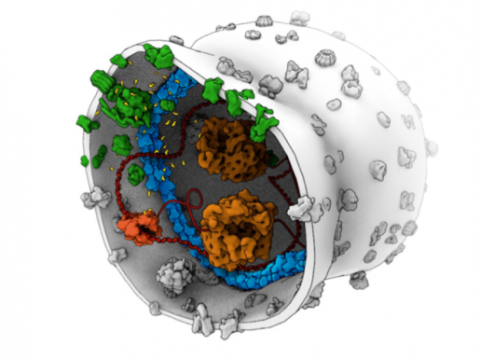Building a Synthetic Cell
NaMeS students are invited to IPC PAS Seminar Lecture:
Prof. Wilhelm T. S. Huck
Radboud University Nijmegen, Institute for Molecules and Materials
The Netherlands
Wednesday 20th December, 2017, 14:00
Assembly hall of the IPC PAS, Kasprzaka 44/52, PL-01 224 Warszawa
Abstract
A cell is the common unit structure shared by all living organisms, but even ‘simple’ prokaryotic cells are extremely complex chemical reactors.
One of the grand fundamental challenges of modern science is to reveal the basic operating principles of life. While we have extensive knowledge about the molecular building blocks that form the basis of modern life, we do not understand how these building blocks collectively operate to define life as we know it. Cellular life, which provides the fundament of all organisms, appears to be the result of a collection of highly controlled, energy consuming, dynamic self-assembly and self-organization processes that lead to autonomous entities that can reproduce, transfer information, interact, and evolve.
Understanding the physical-chemical principles of these collective processes poses a formidable challenge, which needs to be overcome if we want to be able to understand life itself, and influence biological processes in a rational way in the future. Truly understanding life from the bottom-up will bring huge intellectual, scientific, and technological rewards. At the same time it will raise fascinating philosophical and ethical questions about how society may cope with new opportunities that result from this fundamental insight.
In our research, we use microfluidic techniques to create cell-like environments that allow us to probe the impact of the physical aspects of the cell on key biochemical processes such as transcription and translation. I will also give an overview of our current attempts to reconstruct a living cell.
Recent publications:
1. M.M.K. Hansen, L.H.H. Meijer, E. Spruijt, R.J.M. Maas, M. Ventosa Rosquelles, J. Groen, H.A. Heus and W.T.S. Huck, Macromolecular crowding creates heterogeneous environments of gene expression in picolitre droplets, Nature Nanotechnology (2016), 11, 191-197.
2. N.-N. Deng, M. Yelleswarapu and W.T.S. Huck Monodisperse uni- and multi-compartment liposomes, J. Am. Chem. Soc. (2016), 138, 7584-7591
3. S.N. Semenov, A.S.Y. Wong, R.M. van der Made, S.G.J. Postma, J. Groen, H.W.H. van Roekel, T.F.A. de Greef and W.T.S. Huck, Rational design of functional and tunable oscillating enzymatic networks, Nature Chem. (2015), 7, 160-165.
4. E. Spruijt, E. Sokolova and W.T.S. Huck, Complexity of molecular crowding in cell-free enzymatic reaction networks, Nature Nanotechnology, (2014), 9, 406-407.
5. E. Sokolova, E. Spruijt, M.M.K. Hansen, E. Dubuc, J. Groen, V. Chokkalingam, A. Piruska, H.A. Heus and W.T.S. Huck, Enhanced transcription rates in membrane-free protocells formed by coacervation of cell lysate, Proc. Nat. Acad. Sci. USA (2013), 110, 11692-11697.




